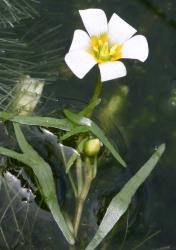Perennial, aquatic herbs; long, flexible, cylindrical, rhizomatous stems. Reproduction sexual or vegetative detachment and regeneration. Submerged leaves conspicuous, deeply and finely palmately divided. Floating leaves, linear, narrow-elliptic, trullate, orbicular, sagittate. Flowers emergent, solitary, actinomorphic, bisexual and protogynous, borne below the water surface on peduncles then elongating above the surface at anthesis; perianth hypogynous, 2-trimerous whorls of tepals (persistent on fruit) occasionally di- or tetramerous, pale yellow, white, occasionally purple-tinged or bright purple; inner tepals with auriculate nectaries. Androecium 3 or 6 stamens, when 3 opposite inner tepals; anthers on filaments of different lengths, dehiscence extrorse; pollen elliptic, monocolpate, tectum imperforate, exine surface mostly striate. Gynoecium 1–3(–4) carpels. Fruit follicle-like, coriaceous, maturation submerged, indehiscent. Seeds 1–5, dispersal hydrochory.
Cabomba is a small genus (Ørgaard 1991; de Lima et al. 2014) found in tropical and warm-temperate America. Leaf dimorphism occurs in all species with peltate, entire, floating leaves and non-peltate, finely dissected, submerged leaves (Ørgaard 1991).
Distinctly dimorphic between submergent and floating leaves. Profuse production of submerged leaves, which are finely and deeply divided into fragile capillary segments. Inconspicuous flowers are produced in the axils of the upper floating leaves.
Species of Cabomba have a floral arrangement of six tepals (3+3), three or six stamens and commonly three carpels, the same as a typical monocot. When there are six stamens Cabomba can be distinguished from most monocots by there being one whorl of six rather than two whorls of three (an exeception is Alisma).
A genus of five species, in the Amazonia region of South America but extending south and northwards from the tropics into the warm-temperate regions of southern South America and North America.
| Category | Number |
|---|---|
| Exotic: Casual | 1 |
| Total | 1 |
Chromosome numbers 2n = 26, 52, 39, c.78, c. 104.




